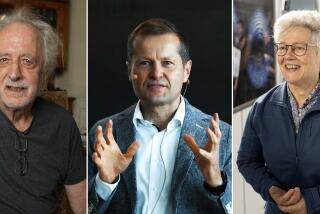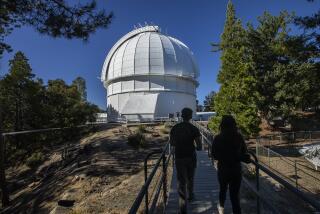Road to the discovery of gravitational waves was riddled with doubt

This short video explains the apparatus that was used to detect gravitational waves passing through the Earth.
- Share via
When scientists at the Laser Interferometer Gravitational-Wave Observatory first realized they had finally detected gravitational waves in September, they kept the discovery largely hidden from the public for close to five months.
But the signal -- borne of a collision some 1.3 billion years ago between two black holes dancing closer and closer together -- was a secret well worth keeping, scientists said, given the history that led up to LIGO’s ground-breaking discovery.
See more of our top stories on Facebook >>
Albert Einstein first proposed the existence of gravitational waves in 1916, as part of his general theory of relativity published the year before. The idea was this: As massive objects accelerate or decelerate through space-time, they radiate energy that’s carried away by gravitational waves -- ripples that propagate through the fabric of the universe.
Even black holes, those massive, unseen objects from which even light cannot escape, might emit these waves under certain circumstances -- if, say, two black holes were circling each other in a binary system, losing energy in the form of gravitational radiation as they drew closer and closer together.
But many researchers doubted that gravitational waves existed at all, arguing that they were essentially a mathematical quirk in a complex but otherwise graceful theory, said Alan Weinstein, a Caltech physicist and LIGO team member. Even Einstein himself came to doubt their existence, going so far as to co-author a paper to that effect (although he eventually reversed this position).
“Einstein’s general theory of relatively is a very mathematically complex set of equations,” Weinstein said. “It’s hard to interpret them correctly. And in particular, there was for a long time the notion that gravitational waves were a mathematical fiction.”
The debate over their existence began to shift thanks to the work of physicists such as Felix Pirani and Hermann Bondi, and particularly at a 1957 physics conference in Chapel Hill, N.C., where theoretical physicist Richard Feynman helped to turn the tide with the “sticky bead argument.”
The idea was that a gravitational wave passing through a stick with a bead on it would cause the bead to move back and forth, heating up both the bead and stick with the friction generated. This would mean that the gravitational waves must not just be mathematical concepts but actually carrying energy themselves -- energy that had been translated into the heating of stick and bead.
Even so, for a long time, gravitational waves were treated more like an intellectual curiosity rather than a physical phenomenon, as Rainer Weiss, one of LIGO’s founders, said in an interview with MIT.
“By the time 1967 had rolled around, general relativity had been relegated to mathematics departments ... in most people’s minds it bore no relation to physics,” Weiss said. “And that was mostly because experiments to prove it were so hard to do -- all these effects that Einstein’s theory had predicted were infinitesimally small.”
But a lot had changed since 1916, he added -- researchers now knew about incredibly dense objects such as neutron stars and black holes, and had new tools (lasers, computers and other electronics) that hadn’t been around six decades before. Another physicist in the 1960s named Joseph Weber had claimed to find gravitational waves using a giant xylophone-like instrument called a resonant bar detector, but no one could replicate his results.
Weiss came up with a different idea, one that would use laser beams to measure the stretching and squishing of space caused by a passing gravitational wave. He wrote about this device, a gravitational wave interferometer, that could hunt for these incredibly tiny signals.
Then, in 1974, Russell Hulse and Joseph Taylor discovered a remarkable binary system: two neutron stars, which are so dense that they each pack about an entire sun’s worth of mass into a region that’s the size of a city. Continued observations showed that the two neutron stars, rather than remaining in a stable orbit around a common center of mass, seemed to be gradually moving toward each other -- and at a rate that matched the prediction of gravitational waves. (The discovery eventually earned the pair the 1993 Nobel Prize in physics.)
While the Hulse-Taylor binary served only as indirect evidence of gravitational waves, the spinning neutron stars still helped show, outside of conferences and college campuses, that gravitational waves could really be out there.
A tipping point came in 1975: Weiss met Caltech’s Kip Thorne after asking him to speak to a NASA committee in Washington, D.C., and the pair had to share a hotel room for the night.
“I was a little leery, to be honest with you,” Weiss said in a Caltech oral history. “I didn’t know the guy. He looked funny as hell to me. I probably looked funny as hell to him. I didn’t know what the hell was going on with the guy. But anyway, we spent all night -- I don’t think we went to bed until about 4 in the morning.”
Thorne (perhaps most popularly known today as an executive producer of the 2014 movie “Interstellar”) was a theorist, but he had become interested in the idea of building some kind of experimental gravitational wave detector. He and Weiss talked into the wee hours about the best way to go about that -- which apparently led Thorne to also conclude that the laser-based instrument would give them the best chance of finding them.
Thorne recruited Ronald Drever, a talented experimental physicist from the University of Glasgow, and the scientists eventually secured funding from the National Science Foundation to look into the idea. But the project suffered from many setbacks -- in part because Drever, according to Weiss’s account, did not want to work with MIT -- and Thorne struggled to hold the partnership together.
“Basically there was a troika,” said Caltech physicist Edward Stone, former director of NASA’s Jet Propulsion Laboratory, who at the time was head of the university’s division of physics, mathematics and astronomy. Being led by three scientists, without much managerial experience among them, did not do the budding project many favors.
“It was really clear toward the end of the ‘80s that we needed to transition to a project, the LIGO observatory, with a director,” Stone said.
Eventually, the National Science Foundation, which has funded the project from its early research days to its construction, mandated that the project be operated by one entity -- which ended up being Caltech -- and that the three scientists cede their control to a single director.
The first run of LIGO, which went from about 2001 to 2010, produced nothing. But this was no surprise, researchers said.
“Before I joined in 1995, it was Barry Barish of Caltech who was the director of LIGO at the time,” Weinstein said. “He went to the NSF and proposed $205 million to build initial LIGO and he was asked at the time whether there was any chance that gravitational waves would be detected with this device. And he said -- I’m paraphrasing -- and he said, probably not; this is a pathfinder to a more advanced detector.”
The plan was to build the detector (two L-shaped detectors with 2.5-mile-long arms, one in Washington and one in Louisiana) and prove that the technology worked the way the scientists thought it would. Once that was done, the next-generation detector could be brought to a high-enough sensitivity to make the discovery -- if there was anything out there to be found.
It was a big risk for the National Science Foundation, said Fiona Harrison, current head of the division of physics, mathematics and astronomy at Caltech.
“This is the amazing thing -- NSF went into that with its eyes open,” Harrison said. Still, she added, “from my perspective now as an administrator, looking back at what my predecessors did, it’s a miracle that it succeeded.”
As expected, at the end of the initial LIGO run in 2010, the detector had found nothing. And in the run-up to advanced LIGO, the project did run into some pushback.
“There were people in the community who said, ‘This is a big waste of money,’” Harrison said.
But after several years of upgrades, the researchers turned the detectors on and began an engineering run in September 2015. And just days in, the detector caught its very first event -- first at the Louisiana detector and then in Washington just 7 milliseconds later.
This told the researchers that the event -- most likely two black holes, with 36 and 29 solar masses apiece, spiraling in toward each other and merging into a single singularity -- was likely happening somewhere in the southern hemisphere’s skies.
The team’s first instinct was to keep this find tightly under wraps until they could verify that the signal was truly from a gravitational wave. That caution had been reinforced by recent experience.
In 2014 the BICEP2 experiment (which originated at Caltech and was co-led by a Caltech scientist) announced with great fanfare that they had found gravitational waves that confirmed the existence of cosmic inflation, the young universe’s dramatic growth spurt. A wave of critiques followed the announcement, ultimately showing that the observations had been confounded by galactic dust.
“We didn’t want to repeat that experience,” Harrison said. “The right way to do things, and the project felt this very strongly, is to have the paper accepted so it has been peer-reviewed.”
The LIGO researchers even worried that a member of their own team had faked it.
“They decided it would have to be somebody who really understood the instrument well enough and the data well enough,” Harrison said. “And they found all such people and interviewed them and determined that in fact nobody had any motivation to do this. So they thought of everything to really vet that this was real.”
There’s a chance to learn more about the makings of LIGO from co-founder Thorne himself. Tonight, at 8 p.m., Thorne, Harrison, Weinstein, Barish and others will give a behind-the-scenes perspective on the search for gravitational waves during a discussion at Caltech’s Beckman Auditorium. Tickets are sold out, but there will be a stand-by line at the door. You can also stream it live in the comfort of your own home.
Follow @aminawrite on Twitter for more science news and “like” Los Angeles Times Science & Health on Facebook.
MORE SCIENCE NEWS
Way beyond diamonds: A look at some of the rarest minerals in the world
Newly discovered Ebola-fighting antibodies could aid vaccine research
After Charlie Sheen revealed he had HIV, Americans turned to Google in record numbers







